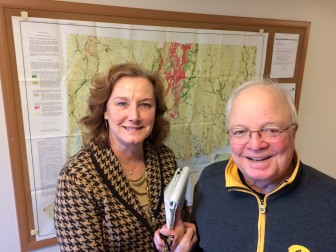New Canaan is seeing an uptick in the number of Inland Wetlands violations cited by the town—an unsettling trend that officials attribute, in part, to a lack of knowledge among homeowners who aren’t checking to see whether their plans require permits.

Inland Wetlands Director Kathleen Holland and Inland Wetlands Commission Chairman Dan Stepanek. Credit: Michael Dinan
Asked to summarize the situation for prospective property owners in New Canaan, Inland Wetlands Director Kathy Holland said: “Buyer beware.”
“Buyer beware of the particulars: lot-by-lot, as far as where the wetlands are located, whether there is good information for that location, whether or not it has been field-tested by a certified soil scientist. That’s the requirement. That’s the only way to know whether wetlands are present or absent.”
New Canaan’s Inland Wetlands Regulations (they can be found, along with other resources, by selecting ‘Inland Wetlands’ from the dropdown menu on this page), like those of other municipalities, follow from what is commonly called the “Clean Water Act” of 1972. The provisions within it protect the environment, and people’s health, by setting standards in areas such as groundwater, flooding, erosion and pollution. They do that, mainly, by requiring studies and permits prior to earth-disturbing activities such as diverting water, filling or removing material or erecting structures in sensitive areas.
“If we don’t have wetlands, we are not going to have drinking water—that’s the bottom line,” Holland said.
Though many professionals in New Canaan—landscape architects and engineers, for example, and the truly active Realtors in town (say, 10 percent of those licensed)—are aware of the regulations and routinely check in at Town Hall to find out whether wetlands exist on a property, others do not, according to Holland and Inland Wetlands Commission Chairman Dan Stepanek.
Though there may be telltale signs that wetlands are present—a brook or swampy area, for example—it’s impossible for anyone to know just by eyeballing a property, Holland and Stepanek said.
Because many New Canaan homes predate the regulations that govern wetlands—and because many properties in town have never been field-tested for their presence—builders and property owners often assume (wrongly) that houses can automatically be rebuilt in or extended from existing footprints, they said. (Septic is also a major driving force in these cases.)
Violators of New Canaan’s wetlands regulations can be divided roughly 50-50 between new and existing homeowners, according to Holland. Two citations that the commission is scheduled to discuss at its regular monthly meeting on Monday serve to highlight the difference: In one case, a Knapp Lane homeowner for more than 15 years was cited last month for multiple violations after extensive unpermitted activities; in another, officials cited a new homeowner on Gerrish Lane who filled in wetlands in his yard. In each case, a $1,000 fine was issued, in addition to the costs incurred with additional testing and labor required to undo or otherwise mitigate the harm done to wetlands.
In some cases, home projects take on a “creeping effect,” Holland said, where a property owner or contractor secures a building permit for one activity—say, extending an attic—“and then the general contractor has been asked to bring 20 truckloads to the site to fill in the backyard.”
“For whatever reason, they get ahead of themselves,” Holland said. “They get so far down that road where they’re trying to please the client, that they create a problem.”
In some situations, property owners who don’t like what a contractor tells them about the prospect of completing a particular project, citing wetlands, appear to run down a list of professionals until they find one who raises no red flags, she said.
Often, the first line of defense, so to speak—the first professional representative of a property in New Canaan—is a Realtor, Holland said.
“They are not expected to know everything, but they are expected to know where to find the information,” Holland said.
“There are obviously savvy buyers, as well, and they are busy. They are hoping their Realtor and lawyer and title searcher have caught everything that needs to be caught, but I will sometimes have a Realtor call me and say, ‘They are thinking of doing a pool here’ and ‘I think there are some wetlands there,’ and I will do a general search based on the information that we know. Then the homeowner will call me. So we do get double questions asked, and I appreciate that type of research, because then it’s not a surprise.”
And when it’s a surprise, that creates a new layer of difficulty for town officials, because commissioners sometimes must instruct homeowners to stop, undo or otherwise adjust their plans—an awkward, frustrating, no-win situation experienced recently by the Zoning Board of Appeals.
The small staff in Inland Wetlands itself cannot proactively discover each instance of violations in New Canaan, though neighbors often step in to flag non-permitted activities.
“We are not going to catch everything,” Holland said. “I often say, there’s one of me, but I have 6,000 agents out there and people will call.”
Is skunk cabbage a “protected” plant in New Canaan ?? I know it’s indicative of wet land but can it be eliminated ?
Please respond.